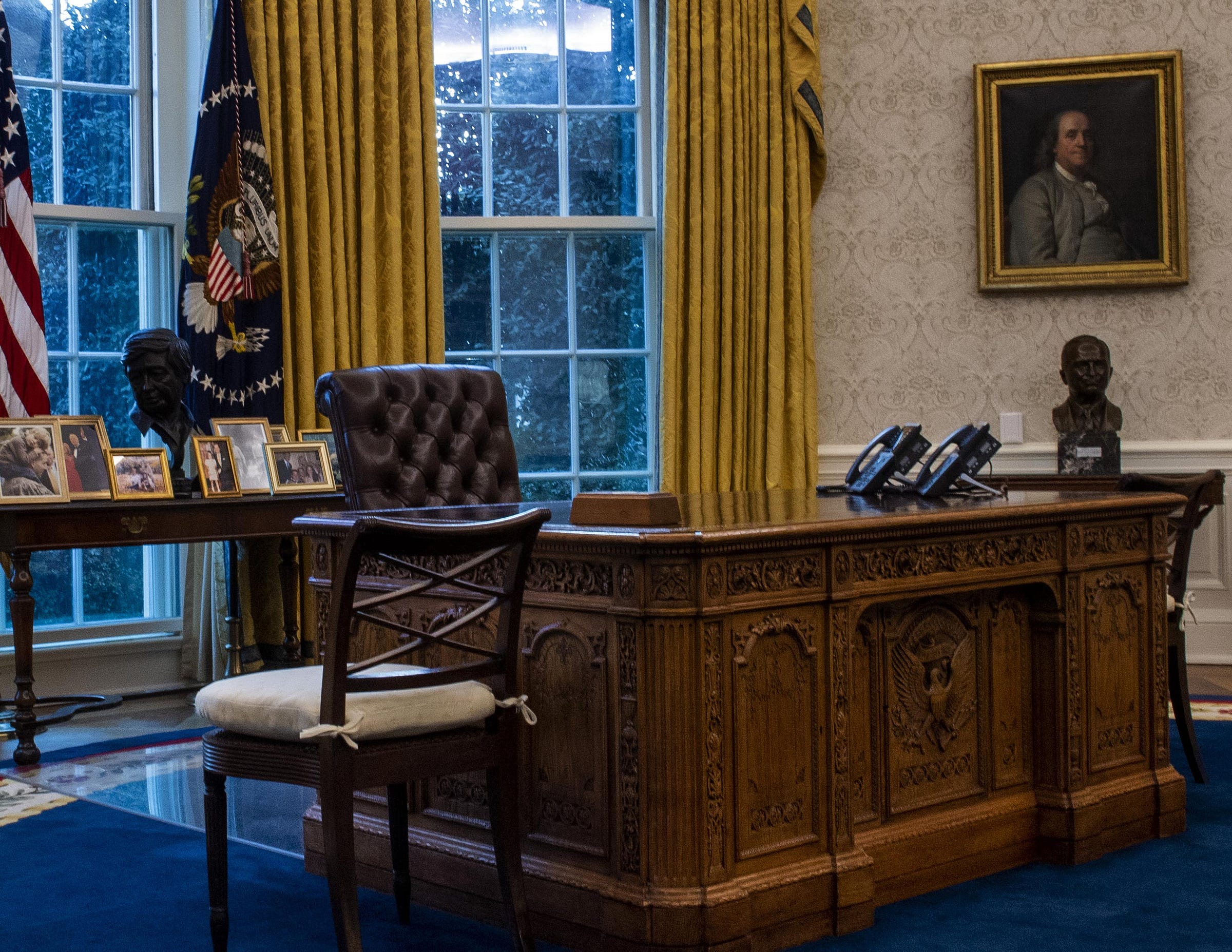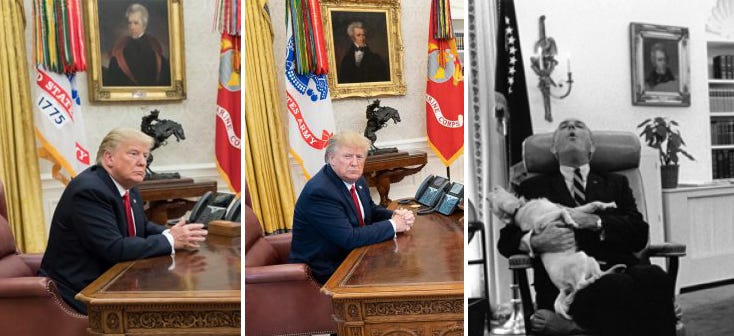Jackson’s Out, the Franklins Are In
How to understand Joe Biden’s choice of Oval Office art.

WHEN A NEW PRESIDENT redecorates the Oval Office, pundits and curious onlookers study every tiny detail, trying to divine whatever esoteric knowledge can be found in the choices of carpet and curtains, of couches and chairs, of photos and paintings and sculptures, of knickknacks on the mantelpiece and shelves and tables. Sometimes this scrutiny gives rise to overblown controversies. Often, though, there are real clues about personality and policy in the choices presidents make. Beyond priorities and private concerns, presidents have also used the icons of the office to send signals about what American traditions they see their administration connecting to and what past presidents they draw inspiration from. For example, Joe Biden has selected a large portrait of Franklin D. Roosevelt to hang above the fireplace in the office, surrounded by paintings of Washington, Hamilton, Jefferson, and Lincoln—a striking break with Oval Office custom, as that space has been occupied by portraits of Washington apparently since Richard Nixon came to office. Before that, Lyndon Johnson, too, displayed a portrait of FDR above the mantelpiece.
Such decisions are not accidental. At least in the Oval Office, a picture really can be worth a thousand words. While President Biden’s decision to give pride of place to Roosevelt is not difficult to explain—after all, Biden often made a point during the campaign of comparing today’s challenges to those FDR faced, and his presidential ambitions to FDR’s—another Oval Office painting switch-up deserves a deeper discussion.
In 2017, Donald Trump selected a portrait of Andrew Jackson to hang in a prominent spot to his left near the Resolute desk. It had been nearly a half-century since any portrait had hung there, most presidents having preferred that spot for landscapes. The last president to put a portrait in that location seems, again, to have been Lyndon Johnson; like Trump, Johnson gave the spot to Andrew Jackson.

Both LBJ and DJT had an affinity for Jackson; in fact, while in office, they each visited Jackson’s home, the Hermitage, respectively on the 200th and 250th anniversaries of Old Hickory’s birth.
DESPITE THE DUBIOUS HISTORICAL LINKS between Trump and Jackson, the forty-fifth president’s admiration for the seventh president inspired much reflection from pundits and historians—from Walter Russell Mead’s concept of “Jacksonianism” to Steve Bannon’s suggestion that the former president should “do what Andrew Jackson did” to Ross Douthat’s description of Trump as “Andrew Jackson in the Persian Gulf.” As Daniel Feller, the former editor of the Andrew Jackson Papers, highlighted in a controversial address last year to the Society for Historians of the Early American Republic, Jackson has served as the perfect symbol for both Trump’s admirers, who see him as a Jackson-like populist champion of the forgotten common man, and Trump’s critics, who see a connection to Jackson’s white-supremacist legacy.
With Trump now out of office, it seems likely that the Treasury Department will resume its plans to replace Jackson with Harriet Tubman on the $20 bill. Either way, he has already been replaced on the Oval Office wall. Joe Biden has selected another portrait to hang on that spot: a painting of Benjamin Franklin by Joseph-Siffred Duplessis, on loan from the Smithsonian’s National Portrait Gallery. In another nod to Franklin, the coat worn by first lady Dr. Jill Biden on the evening of Inauguration Day was embroidered with a quotation that designer Gabriela Hearst credited to the founding father: “Tell me and I forget. Teach me and I remember. Involve me and I learn.” (It is, alas, an apocryphal quote.)
It is an interesting choice, given Franklin’s current place in our pop culture and in the American psyche. He was an important supporting character in the musical 1776 and HBO’s John Adams miniseries, but is absent from Lin-Manuel Miranda’s Hamiliton. (Lyrics that Miranda wrote about Franklin and cut from the show were later set to music and performed by the Decembrists.) Franklin’s name is frequently invoked by rappers referring to his portrait on the $100 bill, as in the words of the recently pardoned Lil Wayne, “Only history I know is Benjamin Franklin.” Thanks to picture books and cartoons, American children still harbor a charming image of Franklin flying a kite with a key during a lightning storm. Yale University recently named one of its two new residential colleges in honor of Franklin. And as with other figures from the founding era, statues and portraits of Franklin have recently been the focus of numerous protests and controversies, including at the University of Pennsylvania, where he was the university’s founder and first president.
GIVEN ALL THIS, what might we make of Biden’s selection of Benjamin Franklin?
Science is clearly the most obvious and popular association with Franklin, something Biden has said will be a hallmark of his presidency. Famous for his kite experiment, Franklin gained international fame for his research into electricity. Less familiar is Franklin’s role in medicine. Not only did he co-found the first hospital in the British colonies, he also supported inoculation to combat the threat of smallpox then ravaging the continent, making him an all-too-fitting figure for our current moment. Joe Biden repeatedly stressed during the presidential campaign that his administration would choose “science over fiction,” and former Vice President Al Gore remarked that when Biden enters the White House “science will walk in with him.” Biden’s embrace of Franklin suggests the leading role he expects science to play in his administration.
More subtly, Franklin’s image also suggests a change in the direction of U.S. foreign policy. One of Franklin’s most significant contributions to the American founding was his role in securing foreign aid and formal recognition from France during the Revolutionary War. Recognizing the need for patience and compromise, Franklin used his international fame as a scientist and distinctive style of personal diplomacy to help ensure the success of American independence. While Donald Trump played an aggressive hand in diplomatic affairs, pushing isolationism and trade wars, Biden will likely try to reestablish and improve ties with our allies; he signals a more conciliatory approach to the conduct of our foreign affairs by highlighting Franklin, who charmed the French court. And Franklin’s image also hints at Biden’s desire to have the United States recognized once again as a leading figure on the world stage.

Ben Franklin’s image also suggests that President Biden will keep in mind issues related to race. Owning at least seven slaves throughout his lifetime, Franklin profited from slavery as a printer by running advertisements for slave sales. He also supported removing the passage condemning slavery from Jefferson’s draft of the Declaration of Independence. After the Revolution, Franklin struggled to reconcile his feelings on slavery with his principles of freedom, and late in life he became an ardent abolitionist. In 1787, he served as president of the Pennsylvania Society for Promoting the Abolition of Slavery.
In an especially memorable episode, Franklin petitioned Congress in February 1790 to abolish slavery. He did this knowing full well that the Constitution forbade Congress from prohibiting the slave trade until 1808. But he also knew that his own personal prestige was so great that Congress would not be able to ignore or downplay a petition with his name attached to it. Both the House and Senate debated the petition before a House committee concluded in March 1790 that the Constitution “restrained” Congress from “interfering in the emancipation of slaves.” Franklin died the next month.
In recent years, Joe Biden has also become vocal about racial issues, citing the horrors of the Charlottesville “Unite the Right” rally in 2017 as his motivation for jumping into the 2020 presidential contest, and calling in his inaugural address for confronting the threat of “white supremacy.” In response to the civil unrest last year prompted by police brutality against African Americans, Biden made a point of rejecting calls to defund the police but made promises to push for criminal justice reform. Both as a candidate and in his first days as president, Biden has challenged Americans to live up to their ideals, including the proposition that “all men are created equal.” Ben Franklin’s story, therefore, from slaveholder to staunch antislavery advocate, can help remind us of the power and importance of living up to the revolutionary promises of the founding.
Of course, the image of Franklin, the American patron of the news media, science, and diplomacy, might be used against Biden as a member of the political elite, out of touch with the problems of “real Americans.” Also, Franklin’s connections to the secretive Freemasons and the mysterious Hell-Fire Club, a notorious organization that supposedly indulged in ritualistic sex and was accused of Satan worship, might also serve as red meat for QAnon conspiracy theorists. Like Biden, Franklin also had a scandalous son, William, who was the source of much personal pain and political drama when he remained a steadfast British Loyalist throughout the Revolution. And it’s not inconceivable that Franklin’s religious views—they were complicated, although he is famous for his skepticism about Christian orthodoxy and ambivalence toward traditional religion—might give critics ammunition to take cheap shots at Biden or Democrats on matters of faith.
Nevertheless, as Jackson was used against Trump, Biden’s critics may well find ways to use Franklin against him. In response to which, Franklin might advise Biden, “love your enemies, for they tell you your faults.” If the age of Trump has been characterized as “Jacksonian,” one wonders if the Biden years will be considered “Franklinian”—for both Benjamin Franklin and Franklin Roosevelt.




